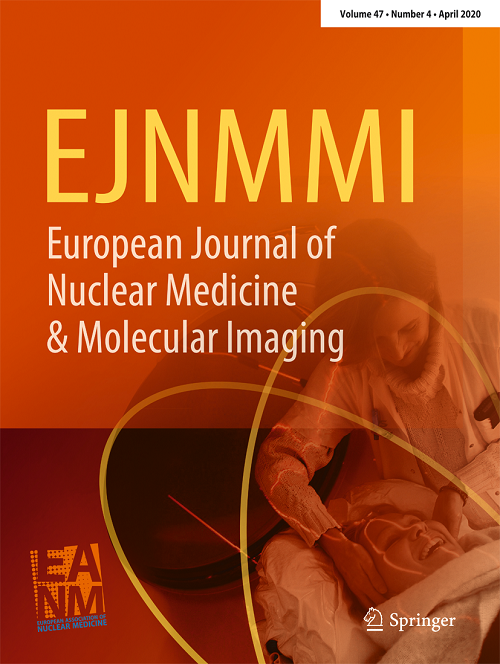有认知症状的长期卧床者大脑代谢连接的持续功能障碍。
IF 8.6
1区 医学
Q1 RADIOLOGY, NUCLEAR MEDICINE & MEDICAL IMAGING
European Journal of Nuclear Medicine and Molecular Imaging
Pub Date : 2024-10-15
DOI:10.1007/s00259-024-06937-x
引用次数: 0
摘要
目的我们的研究检测了急性-亚急性期和慢性期 SARS-CoV-2 幸存者的脑代谢连接性,旨在阐明长期感染者神经症状持续存在的机制。方法我们进行了一项横断面研究,纳入了 44 名接受 FDG-PET 扫描的有神经症状的患者(pts),并将感染时间分为以下几个阶段:急性期(7 pts)、亚急性期(17 pts)和长期期(20 pts)。通过对 FDG-PET 数据进行区域间相关性分析(IRCA)和基于 ROI 的 IRCA 分析,提取急性期/亚急性期和长期期神经-COVID 患者静息状态网络(ADMN、PDMN、EXN、ATTN、LIN、ASN)中的代谢连接性,并与健康对照组(HCs)进行比较。结果急性/亚急性期的特点是 EXN 和 ATTN 网络的超连接性;慢性期相同网络的低连接性。EXN和ATTN的低连接性与长期COVID患者的临床发现一致,如在执行力和注意力领域的神经心理学测试中表现的改变。ASN 和 LIN 在急性/亚急性期表现出高连接性,在长期期则趋于正常。ADMN和PDMN的连接性有所减弱。单变量分析表明,在急性期,前内侧皮层代谢减弱,在亚急性期减弱,在长期期消失。低连接性和无代谢低下表明,额叶网络的连接失调可能与 COVID 患者长期神经症状的延长有关。本文章由计算机程序翻译,如有差异,请以英文原文为准。
Persistent dysfunctions of brain metabolic connectivity in long-covid with cognitive symptoms.
PURPOSE
Our study examines brain metabolic connectivity in SARS-CoV-2 survivors during the acute-subacute and chronic phases, aiming to elucidate the mechanisms underlying the persistence of neurological symptoms in long-COVID patients.
METHODS
We perfomed a cross-sectional study including 44 patients (pts) with neurological symptoms who underwent FDG-PET scans, and classified to timing infection as follows: acute (7 pts), subacute (17 pts), long-term (20 pts) phases. Interregional correlation analysis (IRCA) and ROI-based IRCA were applied on FDG-PET data to extract metabolic connectivity in resting state networks (ADMN, PDMN, EXN, ATTN, LIN, ASN) of neuro-COVID pts in acute/subacute and long-term groups compared with healthy controls (HCs). Univariate approach was used to investigate metabolic alterations from the acute to sub-acute and long-term phase.
RESULTS
The acute/subacute phase was characterized by hyperconnectivity in EXN and ATTN networks; the same networks showed hypoconnectivity in the chronic phase. EXN and ATTN hypoconnectivity was consistent with clinical findings in long-COVID patients, e.g. altered performances in neuropsychological tests of executive and attention domains. The ASN and LIN presented hyperconnectivity in acute/subacute phase and normalized in long-term phase. The ADMN and PDMN presented a preseverved connectivity. Univariate analysis showed hypometabolism in fronto-insular cortex in acute phase, which reduced in sub-acute phase and disappeared in long-term phase.
CONCLUSION
A compensatory EXN and ATTN hyperconnectivity was found in the acute/subacute phase and hypoconnectivity in long-term. Hypoconnectivity and absence of hypometabolism suggest that connectivity derangement in frontal networks could be related to protraction of neurological symptoms in long-term COVID patients.
求助全文
通过发布文献求助,成功后即可免费获取论文全文。
去求助
来源期刊
CiteScore
15.60
自引率
9.90%
发文量
392
审稿时长
3 months
期刊介绍:
The European Journal of Nuclear Medicine and Molecular Imaging serves as a platform for the exchange of clinical and scientific information within nuclear medicine and related professions. It welcomes international submissions from professionals involved in the functional, metabolic, and molecular investigation of diseases. The journal's coverage spans physics, dosimetry, radiation biology, radiochemistry, and pharmacy, providing high-quality peer review by experts in the field. Known for highly cited and downloaded articles, it ensures global visibility for research work and is part of the EJNMMI journal family.

 求助内容:
求助内容: 应助结果提醒方式:
应助结果提醒方式:


